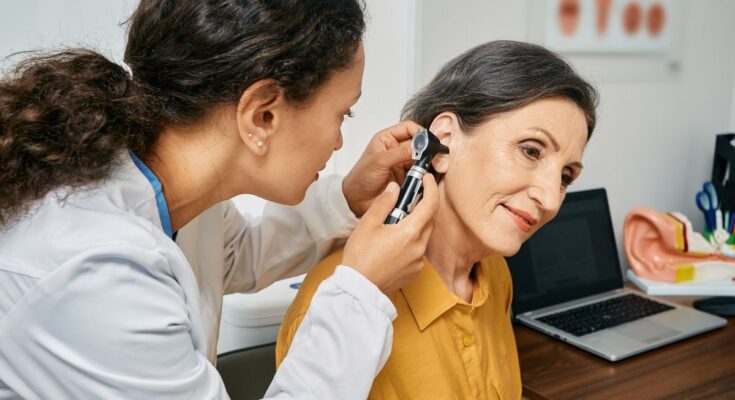Published on
Updated
With an ENT doctor, otoscopy is the gold standard medical examination to examine the external ear canal as well as the eardrum. In which cases is this examination recommended? How does it take place? Explanations from Dr Maria-Pia Tuset, ENT and head and neck surgeon in Paris.
In the daily practice of an ENT doctor, otoscopy constitutes the reference medical examination for auscultating the eardrum as well as the pinna and the external auditory canal of the ear. Apart from this specialist, an otoscopy can also be carried out by a general practitioner or a pediatrician. Several instruments allow this examination to be carried out.
What instruments to perform an otoscopy?
The otoscope is a small hand-held device on which a speculum and light are placed. “Once inserted into the patient's ear, the otoscope allows the eardrum to be viewed in its entirety and its appearance to be checked. A normal eardrum has a clear and translucent appearance. explain Dr Maria-Pia Tuset, ENT and cervico-facial chirurgien in Paris.
Another possibility: using a microscope. “The use of a microscope allows you to increase the visual field and thus have a more precise vision of the eardrum., continues the specialist. Finally, a video otoscope, equipped with a camera, plugs into a phone or computer. This device has the advantage of being able to view the images on the screen, once the instrument is inserted into the patient's ear.
How is an otoscopy done?
Different reasons for consultation lead to performing an otoscopy. A feeling of blocked ear, pain (otalgia), ear infection, discharge in the ears (otorrhea) as well as poor hearing represent the most common reasons. “It is an examination which makes it possible in particular to identify the presence of an obstructive earwax plug or pus in the ear. points out Dr Maria-Pia Tuset. Depending on the case, the doctor will perform suction to clean the infected ear, or wash the external ear canal of the ear using a jet of water, if he notices the presence of a cerumen cap.
Except in very rare cases of ear malformation or closure of the ear canal, an otoscopy is always possible. “This examination, quick and painless, can be performed on an infant from birth and throughout life. specifies the specialist.
Additional examinations
Depending on the symptoms and the results of the otoscopy, other examinations may be considered in order to refine the diagnosis. Thus, if a person consults for hearing loss or a blocked ear, an acoumetry, carried out using a tuning fork, will be carried out. This examination will provide information on the type of deafness that the person may present. “Acoumetry will allow us to know whether it is a hearing deficit coming from the neurosensory cells of the inner ear or rather from the ossicular chain of the middle ear.explains the specialist.
To measure hearing loss, audiometry is a test carried out in a soundproof booth to assess a person's hearing threshold. Wearing headphones, the patient will press the button on a controller as soon as he hears a sound in his ears. If necessary, this examination can be supplemented with vocal audiometry which will determine the patient's word recognition ability. “This will give precise indications as to the origin of the hearing loss, namely an ossicular pathology or damage to the auditory nerve, or even to the brain,” continues Dr Maria-Pia Tuset.
Finally, an impedance measurement makes it possible to measure the elasticity of the eardrum and to test the stapedius reflex of the ear, this involuntary mechanism of the ear which will block the transmission of too intense sound vibrations in order to avoid sound trauma.
Who can use an otoscope?
As a general rule, otoscopy is not a painful or dangerous examination for the ear. However, it is imperative that the otoscopy be carried out by a healthcare professional, particularly in children. “In fact, children have a much more superficial eardrum depth. If the person performing the test is not properly trained, they may cause a perforated eardrum.”alerts the specialist.
Precautionary measures are also required with regard to otoscopes sold over the counter on the Internet to the general public. “Their use can be dangerous, because if the instrument is inserted too deeply, it can not only perforate the eardrum, but also cause dislocation or even fracture of the chain of ossicles located behind the eardrum. warns Dr. Maria-Pia Tuset.




